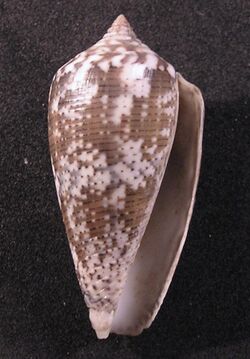Biology:Conus monachus
| Conus monachus | |
|---|---|

| |
| Apertural view of a shell of Conus monachus | |
| Scientific classification | |
| Domain: | Eukaryota |
| Kingdom: | Animalia |
| Phylum: | Mollusca |
| Class: | Gastropoda |
| Subclass: | Caenogastropoda |
| Order: | Neogastropoda |
| Superfamily: | Conoidea |
| Family: | Conidae |
| Genus: | Conus |
| Species: | C. monachus
|
| Binomial name | |
| Conus monachus | |
| Synonyms[2] | |
| |
Conus monachus, common name the monastic cone, is a species of sea snail, a marine gastropod mollusk in the family Conidae, the cone snails, cone shells or cones.[2]
These snails are predatory and venomous. They are capable of "stinging" humans.
Description
The size of the shell varies between 18 mm (0.71 in) and 74 mm (2.9 in). The shell is a little inflated and distantly grooved below. The spire is striate and somewhat convex. The shell is white, longitudinally marbled and flecked with dull blue or purple.[3] It captures its prey by using the "taser-and-tether" (harpoon) strategy. This means it stuns its prey by using venom and extends a proboscis from its rostrum and "hooks" the fish, the same way a harpoon would.[4]
Distribution and habitat
This marine species occurs in the Indo-Pacific. It is found in the neritic zone and resides in muddy sand and under rocks.[5]
References
- ↑ "Supreme Cone Conus monachus". IUCN Red List of Threatened Species 2013: e.T192399A2088081. 2013. doi:10.2305/IUCN.UK.2013-1.RLTS.T192399A2088081.en. https://www.iucnredlist.org/species/192399/2088081. Retrieved 6 April 2022.
- ↑ 2.0 2.1 "Conus monachus Linnaeus, 1758". MolluscaBase. 2015. http://www.marinespecies.org/aphia.php?p=taxdetails&id=215542.
- ↑ Manual of Conchology, structural and systematic, with illustrations of the species. VI. Philadelphia: Academy of Natural Sciences. 1884. https://archive.org/details/manualconch06tryorich.
- ↑ "Prey-Capture Strategies of Fish-Hunting Cone Snails: Behavior, Neurobiology and Evolution". Brain, Behavior and Evolution 86 (1): 58–74. September 2015. doi:10.1159/000438449. PMID 26397110.
- ↑ Palomares, M. L. D. and Pauly, D., eds. (2022). "Conus monachus" in SeaLifeBase. April 2022 version.
Further reading
- "Systema Naturae per regna tria naturae, secundum classes, ordines, genera, species, cum characteribus, differentiis, synonymis, locis." (in Latin). Holmiae (Stockholm): Laurentius Salvius. 1758. http://gdz.sub.uni-goettingen.de/no_cache/dms/load/toc/?IDDOC=265100.
- "One, four or 100 genera? A new classification of the cone snails". The Journal of Molluscan Studies 81 (1): 1–23. February 2015. doi:10.1093/mollus/eyu055. PMID 26300576.
External links
- To World Register of Marine Species
- Cone Shells - Knights of the Sea
- "Pionoconus monachus" (in en). Gastropods.com. http://www.gastropods.com/6/Shell_676.shtml.
Wikidata ☰ Q9866197 entry
 |


